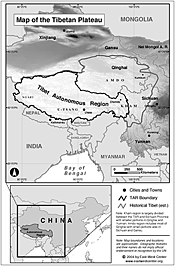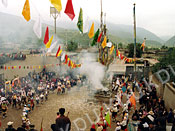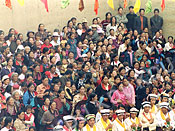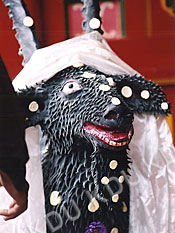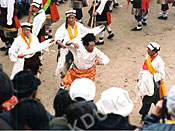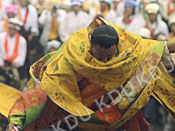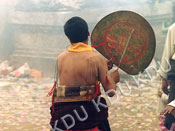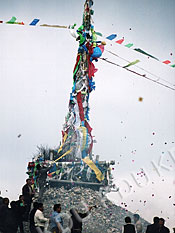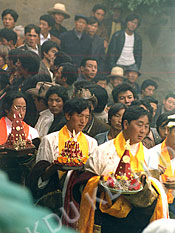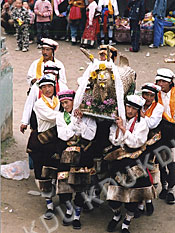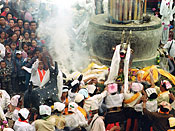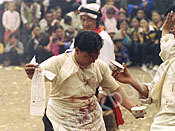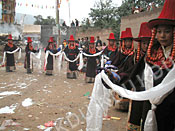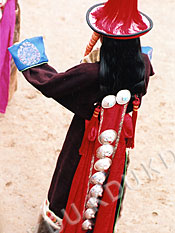![]()
Decomposing the Elements of the Lurol Festival of Tibet as a way of
Interpreting the Tibetan Cosmology
![]()
![]()
For a long time Tibet has been a remote country of mystery shielded by Nature. Its high altitude, strong sun, thin air and geographical inaccessibility*1 led this country to conceal and nurture its own culture and belief. However, its frontier borders attracted the attention of other countries which brought an end to Tibet’s enclosure towards the outside world.
Tibet lies at the skirt of the Himalayas and is now reachable by air or by train (from Beijing, Chengdu or Xining)*2. Only thirty years ago there were no roads, and travel was mainly by foot or by animal force. In spite of this apparent accessibility, a trip to Tibet requires a lot more planning than any other destination. It is advisable to form a group or join a fixed tour even if it means sacrificing one's independence. This is more about safety*3 and guaranteeing efficient transportation, as well as for getting the corresponding permits to enter Tibet. Most of the documents and visas which are needed to enter Lhasa or any other part of the Tibetan Autonomous Region are obtained as part of tour arrangements. They are not given to individuals directly and are issued directly by the Tibet Tourism Bureau as a way to restrict the number of foreigners traveling throughout Tibet*4.
As a citizen of a high-altitude city myself, I had the luxury of traveling through Tibet with no physical ailments, I was, however, well aware of the fact that I was entering a country that was slowly and steadily losing its history, legends and faith. For almost 50 years, as an Autonomous Region of the Republic of China, Tibet has modernized in big steps. As a result, broad and commercial streets are now part of Lhasa. Cultural innovation has usually been controversial, often divisive, with different (and sometimes opposing) religious interests intruding and obstructing the existing traditions. As a result of this, even though festivals are still performed with no major deviations from the existing traditions, there are no more sacrifices of living animals; these have been replaced by dummies made of butter with meat entrails (fig. 4). Although Tibet has not yet developed as a tourist destination it attracts an increasing number of tourists.
The following research report on the Lurol Festival is based on the accounts of a trip made to the northwest borderland of Tibet, in the Qinghai’s Region (fig.1), province of Amdo at the beginning of August, 2004. One can find various cultures interacting in these grasslands: Tu, Salar, Mongol, Hyui, and Chinese.
Religious festivities throughout the world are communal gatherings where people express their faith through acts. The Lurol Festival is one of the few festivals in which the basic four elements (shamanism, offerings, body-piercing or self-torture, fortune telling) of ancient rituals are still performed. Other manifestations of how people relate their existence to their cosmos include: the way they dress, the food they eat and offer, as well as their music and dance. All of these are elements representing the Tibetan faith and cosmology.
It is in this Lurol festival that it is possible to recognize aspects of pre-Buddhist Tibetan Bon Religion within the Buddhist mainframe. My strong interest in this religious festival, and within it, the shamanic rituals, is in finding the facts that push people into the belief of something, how these beliefs appear as a phase of human thinking, when man divides the world into material and spiritual realms and graphically expresses the world. The relational analysis of the visual elements which could be seen in this Lurol Festival are sensory facts constituent of the Tibetan Cosmology.
“… learning from the past we could reinvent a delightful, sensory-based education.”
(Stafford, 1999)
This study analyses the symbolic elements of the Lurol Festival of the ethnically mixed region of Amdo near Tongren in Qinghai’s Huangnan Tibetan Autonomous Region. A lot of people arrived from the surrounding villages to partake in this special ceremony (fig. 3). It is a secular festival held on the sixth month of the lunar calendar for a period of 5 days as a way of praying for good health and a bountiful harvest (like most seasonal festivals in Japan) to their protecting deities such as the mountain gods and the god of the underground, the Dragon. Lurol itself derives its name from the Tibetan Glu or Klu (pronounced both ways). “Glu” means mountain songs and “Klu” makes allusion to the Dragon. The last term “rol” means to play but it alludes to dancing and singing for the gods, feelings of joy and being greeted with a warm welcoming. Although this festivity is given to the dragon, “Glu” seems to be the term for which Lurol was named after (Nagano 1989).
2.1 Elements of ancient rituals
Shamanic Ritual
The central figure of the Lurol Festival is the shaman who acts also as a representative of the town. For this particular reason, foreigners were welcomed by the shaman with the traditional white silk scarf. Traditionally white, this auspicious gift is a symbol of offering a pure mind, heart and motivation (Beer 2000).
Shamanic religious practice is characteristic of hunting and agricultural societies where major decisions are made according to the will of the gods or spirits. Shamanic possession can also be seen in Siberia*5, countries of Southern Africa, Australia, North America, South America and South-East Asia*6 amongst others.
The particular evidences of Bon religion are the shamanistic rituals. Its rituals continues also as the oldest of practices like in the case of Tibet and South Korea, which is still performed amidst their principal Buddhist and Confucian religion, which are more flexible in allowing practices out of their regime. Although it is argue that “Confucianism has made the lives of shamans hellish" (Müller-Ebeling 2000).
Shamanic rituals are performed when the shaman enters into an altered state of consciousness. “To shamanize means to render ‘the spirits subservient to oneself" (Lommel 1967). He (usually a male), is believed to encounter the entities belonging to the spiritual world. As a medium, the shaman can then perform acts of clairvoyance or healing and endure astounding physical performances. The levels of trance and rituals seen in Lurol are not as intense as those that can be seen in other parts of the world which include walking over hot coals, or as in the manshin dances of South Korea, where the manshin or shaman can stand or even jump over sharp blades (Carter 1986).
In Lurol, two shamans are in charge of the religious performances (fig. 5, 6). The principal shaman, who is the head of the town (fig. 6), was constantly and profusely breathing through his mouth, which made a particular sound as that of a horse, and walking in small bouncing steps. This constant repetition of movements and sounds, in this case the drumbeats, absorb the mind and induce an altered state of mind. Both shamans duties seem clearly divided, while one is dress with a white shirt, black pants, a red silk cloth wrap around his hip, and sports shoes, the other is dress elegantly on top with various layers of silk robes one above the other (fig. 6). The former leads and executes the whole procession except for the offerings to the Dragon God which is perform by the latter.
The leading shaman's eyes were barely open, almost as if he just wanted to peek and see where he was stepping. Though he was clearly conscious, it was also evident that he was in an alternate state of mind. His behavior was radically different from the rest of the participants and his influence over the town was what one would expect given his role as the mediator between the spiritual and terrestrial worlds. “The shaman is the centre, the brain, and the soul of such a community. Shamanism goes far beyond common experience, it is the beginning of the belief that the soul can leave the body through trance and that the spirit world exerts influence over the real world. Thus shamanism is above all method, a psychic technique, with which, in a particular cultural situation, especially in a certain ‘dreamlike atmosphere' is still achieved." (Lommel 1967)
Fortune Telling
The shaman is not only a spiritual leader; he is also considered the connection between god, or the spiritual world and the world of humans. This grants him the power to interpret the signals sent from the outer world which are non-intelligible to common people.
In Lurol, the shaman utilizes the horn of a Tibetan gazelle, to predict the fortune of others. He will throw it and observe the way it breaks or shatters. In a way, the resulting fortune is the answer from the gods and shows their satisfaction. Additionally, every one of the self-inflicted tortured dancers (referred to in the next section) will have their fortunes read. If they are not positive, then they will decide if they want to participate in the festival the following year.
The horns of wild animals, like antelopes, deers, gazelles or goats are ritual tools of a shaman, they are sacred that help the shaman in various ways. Horns have points, they lead and guide the shaman either in his journey to the outer world or in his sacred duties.
Self-torture
The male participants between the ages of 18 and 25 will inflict acts of self-torture as part of the festival. This is done as an offering to the gods in essence; they endure this as part of being a human offering. The participation in each dance is done voluntarily. Usually the male member of a family offers himself in this self-torture act when his family has gone through difficult times like the death of a family member, or frequent injuries, sicknesses or accidents throughout the year.
In the first self-torture dance the participants' (12 dancers) mouths are perforated with one or two long needles from one end to the other. These needles have been previously purified with steam. This steam is generated by inserting two large rocks, one white, one black (to represent heaven and the underground) in a bucket of water. Once the needles have been purified, they are coated in butter and inserted through the dancers' lips.
During the second cycle, the dancers backs are pinned with 10 long needles arranged in two rows (fig. 7), they then become both human and blood offerings. In the third and last dance cycle which is the bloodiest, the dancers' foreheads are cut with small blades (fig. 12). As the head is usually a part of the body where blood flows quickly and fluently, the dancers faces are soon covered in blood (their sweat contributes) sometimes impeding even their sight and their faces resembling red masks.
This self-torture dance contrasts enormously with the elegantly costumed women participants which dance ceremoniously and elegantly as an offering to the gods. This is evidence of the division of roles and duties.
Offerings
One cannot travel in Tibet without perceiving the smell of incense and melted butter. Not only inside the Tibetan temples but even in the streets of Lhasa incense fumes constantly welcome the traveler.
Offerings are given for the enjoyment of the gods and procure to satisfy their five senses. For this particular reason, things are offered for their color (painted if necessary), texture, or scent, that is to say, for their sensory attributes. It also represents the offerers' renunciation to those terrestrial pleasures.
| sight | colors and form |
|---|---|
| hearing | music, dance |
| touch | silk |
| smell | incense |
| taste | food |
Previous to the main procession, which is the last and fifth day, the Tibetans make the corresponding preparations which are needed to call the gods to the terrestrial world. It is essential to prepare a clean and pure surrounding for them. This is done through the use of both incense burning and water rituals. The use of fire prevalent throughout most cultures in the world, is known to have the power to kill evil and diseases. As fumes are ethereal and expand wider through the air, helps to have the sensation that air, too, is being purified. The water ritual is done in rivers as their current is considered to possess life force.
The ceremonial place is adorned by strings knotted with multiple prayer flags which are pieces of cotton cloth with mantras (spells, magical words) printed on them. They are strung in sequence colors of red, green, yellow, blue and white which correspond to the Five Buddha colors (fig. 2). They swing high above the ceremonial place, from one extreme to the other of the surrounding walls and the main edifice. They are also called “wind-horses" (Tib. rlung rta)*7,which implies the mantra or prayer can travel through these two magnificent transporters: the wind and the horse. Stepping into mountainous Tibet, the movement in the air is quickly felt, making the fluttering of these flags quite vivacious, coloring temples and hills. They quickly become thick as they are constantly nurtured by the passing pilgrims and travelers who never fail to stop and tie their own prayers to the latse (a cairn of prayer flags) along their way (fig. 8).
The goal in this kind of festivities is to establish contact with the gods, to welcome them into the terrestrial world and offer them what is believed to please them as a way of asking for a fruitful and prosperous year. In these religious festivals, offerings are made to appease the local mountain spirits (an animistic practice) and the god of the underground or dragon. The Tibetans adopted this mystical animal form the traditional Chinese astrological and geomantic representation. It also represents the eastern quarter of the four cardinal directions (Beer 1999).
Offerings, except the liquid ones, are cremated in a huge round altar made of stone which resembles a huge bowl and also contains a huge latse (fig. 11). Located in the center of the ceremonial place, this latse symbolizes the World Tree, the navel, or connector of three worlds: the terrestrial human world, the heavenly celestial world and the underground. It is within this central opening where offerings reach the gods. It is also called the Tree of Life, as it symbolizes the cycle of life and death, the continual regeneration. It has innumerable mythical values in other cultures*8.
When things are consumed by fire, that which is burned changes its form. Fire consumes the object turning it into ashes, becoming a less solid, lightweight physical medium which can be transported into the spiritual world. Its fumes are another state of the object that can travel through the air making it reachable to the gods. It is also believed that it allows the gods to travel from one world to another. Fumes are as ethereal as spirits*9.
Food offerings consist of flowers, roasted barley, bread, yoghurt, butter effigies of goats, sheep, yak, ritual cakes (Tib. Gtor-ma) elaborated with specific shapes and colors and alcohol (Beer 2000). The ritual cakes are molded from butter and barley flour mainly in conical shapes and colored with red dyes.
Colors possess a great deal of meaning, as evidenced by the offerings of red and white. Roasted barley, bread, fruits, yoghurt are amongst the white color offerings, as well as the white silk cloth given for welcoming guests (mentioned earlier). Red color offerings are blood of humans, meat and the butter effigies of goats (fig. 4, 10) and eight red Gtor-mas (fig.9).
The guardians of the town, the mountain deities, are offered red color offerings and warming liquids such as beer and alcohol, and all white offerings mentioned above. The blood, as mentioned earlier is given by self-tortured dancers, which drop their blood directly onto the floor.
As far as the master of the underground, the dragon, white and cool liquid offerings are the most appropriate. This includes yoghurt and water which are disposed in small bowls and are poured directly to the soil. Dancers carry it on one hand while dancing and drip them little by little to the soil as if gently feeding it (fig. 12). Water is given by the second shaman after wearing many layers of embroidered silk strings of cloth coloured in red, yellow, green and blue (fig. 6). The dragon is associated to the underground waters and springs which are even known as living dragons (Beer 1999). This could be the reason for dripping their offerings to the floor. This god does not eat meat so willow is offered instead.
Many pre-monotheistic religions have included sacrifices of animals (or even humans) as part of their offerings to the gods. This is primarily based on the concept that there is no life without death (Müller-Ebeling 2000). The early Aztec culture of Mexico, for example, offered the beating hearts of human beings to their Sun God. They nurture the god with blood in exchange for daily sunshine and good weather. It was an honor for a man to die in this way, as they were guaranteed a space in the afterlife, since they had fed the god with their own life.
2.2 Music and Dance
The main driver for this festival is to ensure that the gods are both content and satisfied. Therefore, as with any other festival of this kind, there is no apparent lack of music, food, and dance.
The central altar serves as the axial point where dancers perform. Dance sequences and performances are repeated within cycles. In between these cycles, costumed comedy skits were enacted by villagers. These theatrical performances of social content entertain the spectators and offer a break to both viewers and the religious ritual itself.
People's clothing is unique and colorful for this special occasion. Not only are they special for the occasion but are also laden with significance. Single women dance with a dress which is the allusion to the dragon (fig. 13). The golden concentric adornments at their backs resemble the mystical flaming pearls that accompany the dragon while others say they are dragon scales (fig. 14). These scales are generally painted in different methods, either as reptilian scales or as rows of variably sized circles or ellipses. They sum nine in total, as the number nine has a magical numerological affinity with the dragon ―it has nine varieties, nine likenesses, eighty one (9x9) total dorsal scales (Beer 2000).
The reason that single women dedicate this dance to the dragon can be found in the fact that the dragon represents the strong male yang. As some Japanese anthropologist explained, in Japan, female participation was forbidden in some festivities and mountain temples not as a discriminative rule but mainly because it could cause the jealousy of the goddess (as mountain gods were usually female).
2.3 Musical instruments
Drums
As in any case of shamanic ritual drums are inevitably used, this is because, they are helpful instruments in reaching a state of altered consciousness or trance, which is the end-state desired by the shaman. Their repetitive drumming (listen sound) and chanting distracts the mind and empties it. Drums are not merely musical instruments but they are also the symbol of creation. This is the reason why they are related to the Tree of Life and the explanation to why wooden sticks are used.
The hand drums of the dancers which are the ones that inflicted the acts of self-torture are thin and round as a fan (fig. 7). They are made of goat skin ornamented with the figure of the dragon among others. The purpose of the drums is not for producing music but it is rather for allowing the sound or voice of the spirits to come out as it is thought that the animal spirits are carried within it. Thus calling the gods to them.
Trumpets
Conch shells are used as trumpets and have been a sacred instrument for centuries. The conch shell occupied an important role in magic and ritual practices of numerous tribes of America, too. In Initiation ceremonies of the ‘Great Medical Society of Winnebago' (American Tribe) the conch shell appeared to be an indispensable element in rituals of Death and Rebirth of a person. In these rituals the conch shell, which is carefully kept in a bag of otter skin, is played. These same mythical ceremonies exist in Indonesia, Melanesia and Australia (González Torres 2001). In Siam, Thailand, priests play the conch shell when the agricultural season starts. In addition, in the coast of Malabo, when the first seasonal fruits are collected, the priest leaves the temple preceded by a man who plays the conch.
In Tibet, it is believed that the conch shell will make all evil spirits vanish, avert natural disasters, and scares away poisonous creatures. It has a metallic mouthpiece with auspicious symbols carved on it. Conch shells are not only musical instruments, they are frequently found depicted on temple walls as containers of perfume and incense offerings.
2.4 Tibetan Cosmography
“Man uses the spoken or written work to express the meaning of what he wants to convey. His language is full of symbols, but he also often employs signs or images that are not strictly descriptive. Because there are innumerable things beyond the range of human understanding, we constantly use symbolic terms to represent concepts that we cannot define or fully comprehend. This is one reason why all religions employ symbolic language or images. Both his conscious use of symbols is only one aspect to a psychological fact of great importance: Man also produces symbols unconsciously and spontaneously" (Jung 1968).
Both male and female dancers wear a red tall hat. These hats represent Mt. Meru (Tib. Ri-rab), the central mountain or axial centre of the universe within both Hindu and Buddhist cosmography.
According to the Tibetan Book of The Dead (which is one of the most complete books on Tibetan thoughts), Mount Meru is considered the axial centre of the Universe, equal to the sun of our planetary system. It parallels the importance bestowed on Mt. Olympus by the Greek or the Golgotha for early Christians, to mention only a few examples. Mount Meru seems to reach up into the skies, and has the roots of such monumental structure deeply rooted in earth; as such, it can connect both earth and sky. For this reason, mountains are depicted as sacred. Nonetheless, they are static but grandiose, the clouds or snow on its top, generates water and river flows, gives birth to vegetation, attracting various animals originating life in itself by simply prostrating there silently.
Mount Meru emerges from an ocean, below it are four lower terraces or realms one above the other. Its eastern face is formed of white crystal, the south of blue lapis lazuli or sapphire, its western face is of red ruby and its northern face is made of pure gold. Thus, the colors reflect the directional face of Mt. Meru*10.
What lies upon Mount Meru are the heavens and below are the various hells. Surrounding it are fifteen expanding concentric layers. The innermost layer contains Mount Meru and its surrounding ocean, followed by a layer where seven concentric circles of oceans exist and from where golden mountains arise. The outermost fifteenth layer includes the continents and their satellites. This totals one universe which is enclosed by a wall made of iron. Beyond this wall lie other self-contained universes; as this, lies beyond other universes indefinitely*11.
There are slight differences among the existing explanations of Mount Meru and its cosmography. This conceptual structure of Mount Meru should not be taken as a fixed one. However, this progressive and multilayered approach to the constitution of the universe or the cosmos leads one to think of the Buddhist predisposition towards continuity, and how things invariably go through different phases. This also explains some of the reasons why Eastern cultures do not fear the ever after, as opposed to their Western counterparts. This idea of progression, continuity, continual regeneration, and infinity is also implied in the presence of the Cosmic Tree, a representation of the cycle of life. In this ceremonial place is represented by the central altar disposed in the center of a squared space. Therefore, not only the garments represent the cosmic structure of the universe but also the ceremonial space is designed like it. All religious sites have the layout representing this cosmography, a humanly scaled cosmos.
2.5 Conclusion
Graphic and symbolic expressions are tools that manifest people's thought. As Lotman clearly explains in regards to the typology of cultures, everything not merely words but also things, signifies a higher reality and objects themselves are important not for their physical nature or their function, but rather in as much as they signify something else (Lotman 1990).
Religious and artistic motifs exteriorize human thoughts in a visual, perceptible form. Most of the Tibetan motifs are inspired from their perception of the Cosmos. By understanding the whole perception it is possible to understand the elements which form part of it.
When knowledge starts to be transferable an ideology has the power to become more concrete, to define and accentuate its conception and diffusion. The study of these facts leads to the knowledge of a society, its environment and the relationship with it.
In this way, the symbolic features used by Tibetans in the Lurol festival are means of communication with the other world and their society. Each symbol has a meaning and a reason for being there in that particular moment. In the same way, each form and color, are concrete manifestations of their belief. In viewing elements like the offerings we can see the actual value of things. The offerings given to the gods transcend more than just the physical objects used as connecting elements between this world and the one where their god is believed to reside.
"Great images have both a history and a prehistory; they are always a blend of memory and legend, with the result that we never experience an image directly." (Bachelard 1964)
It can be said that what happens in a festivity is particularly the connotation of people's fear and hope. As a direct result of facts, medical and scientific advances as well as the political changes reaching Tibet, their perceptions are bound to change - one could even argue that they have already begun to change. It is also visible that the presence of the foreign eye has an effect in their religious practices. It could well be expected that Shamans will perform less and less medical tasks, and that they, like many other things will become a thing of the past. Only in the last 300 years have religion and science come apart as ways of exploration (Bowker 2003).
For the contemporary man, sacrifices and self-torture are beyond understanding. The acts of a shaman are even interpreted as a psychotic phenomenon; some foreigners cruelly judge this as pure exhibitionism. Trying to explain or get a scientific answer would be unsatisfying. As the renowned psychiatrist Carl Jung explained ―“It would be a major task to understand the whole process of trance. All human beings want themselves to be of value and our lives and activities to have value, when all this form an organic unity then the human being feel the proper relief. In this situation the rational, the courageous, and the appetitive as Plato viewed it are a proper state of the soul. We encompass a diversity of phenomena uniting them through many cross connections in an integrated way, which feeds our activities in a productive way" (Jung 1981).
Images and symbols possess meaning and value in a concrete social context. As mentioned before, early Aztecs of Mexico were considered savage by the Spaniards. They were horrified to see the execution of human sacrifices, the adornment of skulls unbearable. Human sacrifices were performed for nurturing their Sun God, their provider of life force. They were not an act of killing or murder. It is unnecessary to explain why the sun possesses such power for giving life; earlier people revered this natural phenomenon and were grateful for it. Spaniards were horrified to see human sacrifices but they executed and burned indigenous people for being thought to be possessed by evil spirits, they also hung their heads to remind the population of the consequences of disobedience.
In the same way, for the Tibetans, mountains, rivers, and human blood are considered essences of life, valuable things. Tibet is not an easy place to live in. The living conditions are poor, but one can always take comfort in hearing their chants and knowing they have strong beliefs. Their religious architecture represents the whole cosmos, their offerings and faith are brought to life through their use of bright colours, which adorn the walls wherever the eye may wonder.
We can feel, touch, see, taste and hear; but how far we can see or hear depends on the quality of our senses. Festivals around the world offer a very unique sensuous world. The roots of these festivals are grounded in giving the gods or a superior being all that is needed in order to keep them happy and satisfied. Their dissatisfaction can provoke their despair or discontentment and bring chaos, tragedies, sickness or misfortune. Their contentment can bring fortune, good harvest and health. Each element possesses a symbolic meaning about life, birth, and death. Research within these ideas and perceptions can bring valuable insights into the nature of the different symbols used by a culture. For this reason, the seasonal festival of Lurol was considered in this research. This paper focused on the elements and their perception in regards to form, but there were also various numerical facts present, which will be subject of the next research.
“What exactly you believe, and how much, and why, is one of the questions Tibet asks you more searchingly than any place I know" (Iyer 2004).
Bibliographical References
Bachelard, Gaston. The poetics of space; translated from the French by Maria Jolas; foreword by John R. Stilgoe. Beacon Press: Boston, 1994.
Barrow, John D , The infinite book: a short guide to the boundless, timeless and endless. Pantheon Books: NY, 2005.
Beer, Robert. Deities of Tibetan Buddhism. Wisdom Publications, Wisdom Publications: Boston, MA, 2000.
Bowker, John. World Religions. Dorling Kindersley: London, 2003.
Brooke, John Hedley. Science and religion: some historical perspectives. Cambridge University Press: USA, 1991.
Brotherston, Gordon. La América Indígena en su literatura: los libros del Cuarto Mundo. Fonde de Cultura Económica, 1997.
Caldecott, Moyra. Myths of the Sacred Tree. Destiny Books: Rochester, Vermont,1993.
Carter Covell, Alan. Folk art and magic: Shamanism in Korea. Hollym International, Elizabeth, N.J.,1988.
Cuevas, Bryan J. The Hidden History of The Tibetan book of the Dead. Oxford University Press: USA, 2003.
Dorje Gyurme. Tibet Handbook. Footprint Handbooks, Ltd: U.K., 1999.
Eliade, Mircea. Shamanism: archaic techniques of ecstasy, translated from the French by Willard R. Trask. Princeton University Press: Princeton, N.J.,1972, c1964.
Evans-Wentz, W.Y. The Tibetan book of the dead, foreword by Donald S. Lopez, Jr. Oxford University Press: London, 2000.
Holenstein, Elmar. Philosophie-Atlas: Orte und Wege des Denkens. Ammann Verlag: Zurich, 2004.
Jung, Carl G. Man and his symbols. Dell Pub., (A Laurel edition): USA, 1968.
Jung, Carl G. The Structure and Dynamics of the Psyche. Princeton University Press: USA, 1981.
González Torres, Yolotl. Animales y plantas en la cosmovisión mesoamericana. Plaza y Valdés: México, 2001.
Kyoto Journal, Perspectives on Asia. no. 57 (2004). Heian Bunka Center Publisher: Kyoto, Japan.
Laufer, Berthold. Origin of the Word Shaman. American Anthropologist, New Series, Vol. 19, No. 3 (Jul. - Sep., 1917): 361-371.
Lommel, Andreas. Shamanism: The Beginnings of Art. McGraw-Hill: Great Britain, 1967.
Lotman, Yuri M. Universe of the mind : a semiotic theory of culture, translated by Ann Shukman; Introduction by Umberto Eco. Indiana University Press: Bloomington, 1990.
Müller-Ebeling, Claudia; Rätsch, Christian and Bahadur Shahi, Surendra. Shamanism and Tantra in the Himalayas. Thames & Hudson: London, 2002.
中川真「音のかなたへ:京都・アジア・ヨーロッパの音風景」NHK人間講座、2001年8月~9月号。
荒川紘著「東と西の宇宙観/西洋篇、東洋篇」紀伊國屋書店:東京、2005。
長野禎子「神と人との交流の宴 ルロ」季刊民族学編集部/国立民族学博物館友の会、89(夏)号。
北山耕平著「ネイティブ・マインド: アメリカ・インディアンの目で世界を見る」地湧社:東京、1998。
頼富本宏編「聖なるものの形と場」法藏館:京都、2004。
The official website of the Beijing 2008 Olympic Games:
http://en.beijing2008.com
China Highlights:
http://www.chinahighlights.com/tibet/visa_document.htm
Map of the Tibetan Plateau:
http://www2.eastwestcenter.org/ environment/spatial/ewc_sdi/maps/tibet.pdf
- *1―
- Lhasa, the capital, is at an altitude of 3,600 meters, and any overland route requires crossing mountain passes at 5,000 to 6,000 meters (Mt. Everest, on the Tibet-Nepal border is 8,848 meters).
- *2―
- http://en.beijing2008.com
- *3―
- In the year 2000 according to Matsumoto Eiichi, a professional photographer which joined the same tour group, 7 Japanese students have disappeared during their trip.
- *4―
- http://www.chinahighlights.com/tibet/visa_document.htm
- *5―
- The word shaman derives from the word saman of Tungusian tribes of Siberia (Laufer,1917).
- *6―
- Shamanism in Tibet is far a continuation of a previous research on the migration of Asian people to the American Continent. The fact that such a primitive religion was also practice in the Americas gave more insights to accentuate the fact and has been a topic covered by many other scholars in an anthropological way of view.
- *7―
- Note on Tibetan Words: Tibetan words are written according the quotes of other academics or researchers on Tibetan studies. There were infinite variations. Proper Tibetan spellings are given according to the Wylie transcription 1959.
- *8―
- Such as in the ancient Mayan culture, where the Ceiba was considered as a holy tree, for it's capacity to connect the world of spirits with the world of mortals.
- *9―
- It will be refrained here to denominate or explain what a spirit is under the materialistic academic dogma, but it will be considered as a necessary phenomenon in the process of this Lurol Festival and the Tibetan belief.
- *10―
- Assigning colours to the cardinal points can also be seen in the Navajo Indians and Mexican Maya and Aztec cultures.
- *11―
- The Tibetan Book of the Dead, W.Y. Evans-Wentz, pg. 62-64.

